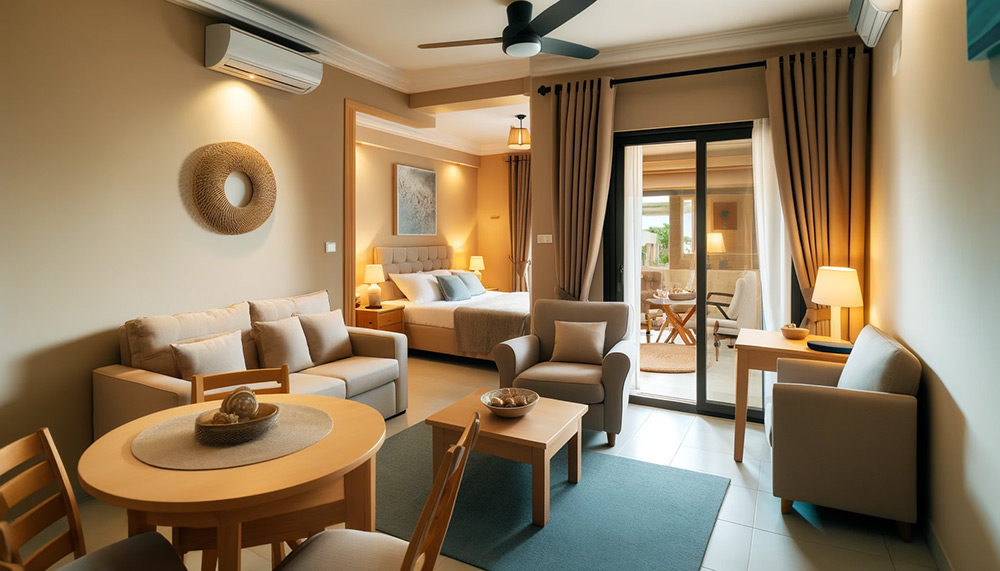Welcome to our comprehensive guide on optimising the occupancy rate of your holiday rental property! Whether you’re a seasoned host or new to the holiday rental scene, maximising bookings is essential for success. In this article, we’ll explore practical strategies to boost your property’s occupancy rate throughout the year. From pricing and marketing to guest experience and beyond, we’ll cover everything you need to know to keep your property booked and guests happy. Let’s dive in!
Holiday Rental Occupancy Rates – What are they?

Holiday rental occupancy rates refer to the percentage of time that a holiday rental property is occupied by guests over a specific period, typically measured on a monthly or yearly basis. In simpler terms, it’s a way to measure how often your property is booked by guests compared to the total available time.
For example, if you rent out your holiday home for 30 days in a month and it’s occupied by guests for 20 of those days, your monthly occupancy rate would be 20 divided by 30 then times 100, so 66.67%.
Occupancy rates are crucial for holiday rental owners and managers because they directly impact revenue. Higher occupancy rates mean more bookings and more income, while lower rates can lead to lost revenue and potential financial challenges.
Breaking down occupancy rates into seasons
Breaking down occupancy rates into seasons provides valuable insights into the ebb and flow of demand for holiday rentals throughout the year. By understanding the seasonal patterns of occupancy, owners and managers can make informed decisions about pricing, marketing strategies, and property management practices. For instance, they can adjust pricing to maximise revenue during peak seasons when demand is high, while offering promotions or discounts to attract guests during off-peak periods. Additionally, seasonal analysis allows owners to anticipate busy periods and plan ahead for maintenance, cleaning, and guest services, ensuring a seamless experience for visitors year-round.
How to calculate your Holiday Rental’s occupancy rate
Occupancy Rate Formula = ( Number of Booked Nights / Total Available Nights) ×100.
If you wish to calculate your yearly occupancy rate, follow the following process:
- Collect Total Nights Booked For The Year:
- 2024 Nights Booked = 267
- Perform calculation:
- Occupancy Rate = ( 267 / 365) ×100 = 73.15%
What are the average occupancy rates?
Understanding the average occupancy rates in the holiday rental market provides valuable insights into the overall performance of properties in different countries and regions. In this section, we’ll delve into the average occupancy rates for holiday rentals in the UK, Spain, and the USA.
UK Occupancy Rates
Sykes Cottages provides insights into holiday let occupancy rates across the UK, highlighting regional and seasonal variations. The average occupancy rate in 2022 was 32%, with notable rates in regions such as Northumberland (35%) and the Scottish Highlands and Islands (40%). Seasonal trends show higher occupancy during spring and summer, with Southern Scotland achieving 49% in winter and the Scottish Highlands and Islands 61% in spring. Factors influencing occupancy include property size, location, pricing, and marketing strategies.
According to a report from Hostpitable, the average Airbnb occupancy rate in the UK is around 50-60%, varying by location. Major cities like Edinburgh and London boast higher rates, often reaching up to 90% and 80%, respectively. Other cities such as Bristol, Glasgow, and Cambridge have occupancy rates ranging from 73% to 77%. The data underscores the significance of location, pricing strategies, and effective property management in achieving higher occupancy rates.
Spain, Anadulisa Occupancy Rates
In 2023, Andalusia’s short-term rental market experienced notable fluctuations in occupancy rates, reflecting both seasonal trends and market recovery post-pandemic. The highest occupancy rate was observed in August at 68%, showcasing the peak summer tourism period, while the lowest was in January at 38%, highlighting the off-season dip. The average occupancy rate from January 2023 to November 2023 was approximately 50.36%, indicating a relatively balanced demand across different months.
USA, Florida Occupancy Rates
According to PriceLabs, Florida’s short-term rental market shows significant seasonal fluctuations in occupancy rates. The highest occupancy rates are typically observed during the winter months when tourists flock to the state to escape colder climates. For instance, Cocoa Beach had an average occupancy rate of 64% in 2021, while other popular destinations like Fort Lauderdale and Butler Beach had rates of 54% and 58% respectively. On the lower end, cities like Daytona Beach and Jupiter had occupancy rates of 49% and 38%.
What can cause low occupancy rates for your holiday rental?

- Seasonal Demand: Demand for holiday rentals often fluctuates throughout the year based on factors like weather, school holidays, and local events. Low occupancy rates may occur during off-peak seasons when fewer travellers are visiting the area.
- Pricing: Overpricing or underpricing your rental property can impact occupancy rates. If your rates are too high compared to similar properties in the area, it may deter potential guests. Conversely, setting rates too low could signal lower quality or lead to missed revenue opportunities.
- Competition: The holiday rental market in the UK is getting busier with more properties popping up all the time. This means there’s a lot of competition out there. If your place doesn’t have something special that makes it stand out, it might have trouble getting booked. It’s like being in a big crowd – if you don’t do something to catch people’s eye, they might not even notice you. That’s why it’s important to make your property unique and appealing to guests.
- Marketing and Visibility: Inadequate marketing efforts or poor visibility online can limit your property’s exposure to potential guests. If your listing doesn’t appear prominently in search results or lacks compelling photos and descriptions, it may fail to capture the attention of travellers.
- Property Condition: The condition and upkeep of your rental property play a significant role in attracting guests. If your property is outdated, poorly maintained, or lacks essential amenities, it may receive negative reviews and struggle to secure bookings.
- Location: The location of your holiday rental can influence its appeal to travellers. Properties in less desirable or remote locations may experience lower occupancy rates compared to those in prime tourist areas or with scenic views.
- Reviews and Reputation: Negative reviews or a poor online reputation can deter potential guests from booking your property. Addressing guest concerns promptly and maintaining a positive reputation through excellent service and communication is essential for attracting bookings.
- Booking Policies: Restrictive booking policies, such as minimum stay requirements or inflexible cancellation policies, can limit your property’s appeal to guests. Offering flexible booking options and accommodating guest preferences can help improve occupancy rates.
How to increase your holiday rental’s occupancy rate
Increasing the occupancy rate of your holiday rental is crucial for maximising revenue and ensuring the success of your property. Here are some detailed strategies to help you boost occupancy rates:
- Establish a Strong Brand and User-Friendly Website:
- Develop a unique brand identity that reflects the personality and values of your holiday rental property.
- Create a user-friendly website that showcases your property, amenities, and local attractions.
- Implement online booking functionality and secure payment options to facilitate direct bookings from guests.
- Invest in search engine optimisation (SEO) and digital marketing strategies to drive traffic to your website and increase direct bookings.
- Optimise Your Pricing Strategy:
- Conduct thorough research on comparable properties in your area to understand market rates and demand trends.
- Adjust your pricing strategy dynamically based on factors such as seasonality, local events, and demand fluctuations.
- Consider offering discounts or special promotions during off-peak seasons to attract guests during slower periods.
- Enhance Your Property’s Listing:
- Invest in professional photography to showcase your property in its best light and highlight its unique features.
- Write compelling and detailed descriptions that highlight the benefits and amenities of your property.
- Update your listing regularly with fresh content, including guest reviews and testimonials, to maintain relevance and credibility.
- Improve Guest Experience:
- Prioritise cleanliness and maintenance to ensure that your property meets or exceeds guest expectations.
- Provide thoughtful amenities and conveniences that enhance the guest experience, such as complimentary toiletries, Wi-Fi, and kitchen essentials.
- Offer personalised touches or services to make guests feel welcome and valued during their stay.
- The aim here is to get good guest feedback
- Utilise Multiple Distribution Channels:
- List your property on multiple online booking platforms, such as Airbnb, VRBO, Booking.com, and Expedia, to expand your reach and visibility.
- Utilise channel management software to synchronise availability and rates across multiple channels and avoid double bookings.
- Consider partnering with local travel agencies or tourism websites to attract additional bookings from offline channels.
- Implement Effective Marketing Strategies:
- Develop a comprehensive marketing plan that includes both online and offline tactics to advertise your holiday rental.
- Leverage social media platforms to showcase your property, engage with potential guests, and share user-generated content.
- Collaborate with influencers or bloggers in the travel and hospitality niche to increase exposure and reach new audiences.
- Offer Flexible Booking Policies:
- Provide flexible booking options, such as same-day bookings or free cancellation policies, to accommodate the changing needs of travelers.
- Consider offering long-term rental discounts or extended stay packages to attract guests looking for extended vacations or remote work opportunities.
- Solicit Feedback and Reviews:
- Encourage guests to leave reviews and feedback after their stay to build trust and credibility with potential guests.
- Actively monitor and respond to guest reviews, addressing any concerns or issues promptly and professionally.
- Use guest feedback to identify areas for improvement and make necessary adjustments to enhance the guest experience.
Conclusion
Occupancy rates for holiday rentals exhibit significant seasonal variations, generally peaking during high-demand periods like winter months and dipping during off-peak times. Property managers and owners have substantial opportunities to improve these rates through strategic actions. Implementing dynamic pricing, enhancing property marketing, and maintaining high property standards are essential steps. By staying informed about market trends and leveraging data analytics tools, such as those offered by Airbtics, managers can make data-driven decisions to boost occupancy rates and overall profitability.

